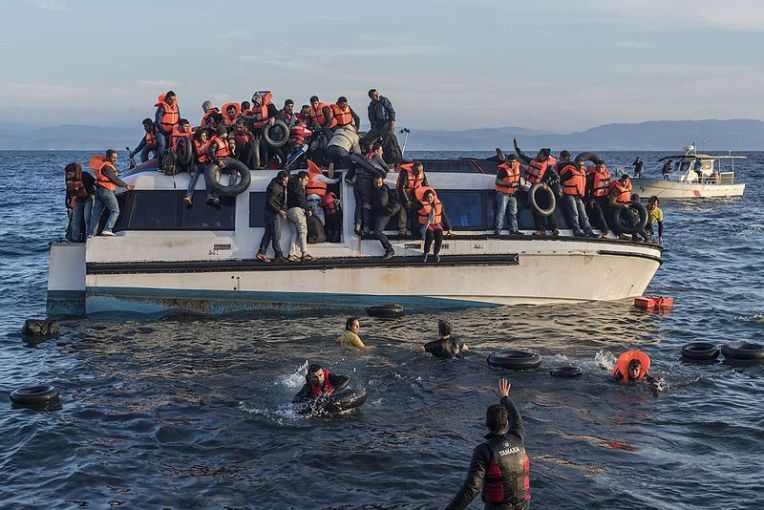I’ve been thinking about this one for a while. It’s about the refugees flooding Europe. Millions, we’re told. I don’t buy it.
I started writing this after hearing about the Jugend Rettet Iuventa rescuing 400 people (including seven pregnant women) from drowning in the Mediterranean. It’s important that you see where I’m going with this, so I’ll quote from The Maritime Executive’s Migrant Rescue Vessels Overwhelmed, Send Mayday:
The Iuventa, Jugend Rettet ship, had 400 [some other newspapers said 600 –Kaz] rescued migrants on board, including seven pregnant women, and was concerned that many might lose their life as weather conditions worsened. The Sea-Eye had 120 people on board including 10 casualties.
Mélanie G?odkiewicz, Advisor at Human Rights at Sea, said that on Monday those rescued by Iuventa were transferred to the VOS Hestia, an NGO-led vessel from Save the Children, in the lee of the tanker Stemnitsa, responding at the scene. Those on board are being taken to Malta.
The migrants on board the Sea-Eye were rescued by two vessels from the Italian Coastguard and are being taken to Italy.
So the facts are these:
- The Iuventa picked up 400 people. Or 600 people.
- The weather began to worsen.
- The Iuventa, afraid of the worsening weather conditions, called a Mayday.
- A bigger ship came along and all 400 (or 600) people were rescued.
Fine. What kind of ship is the Iuventa? According to the parent organisation, Jugend Rettet:
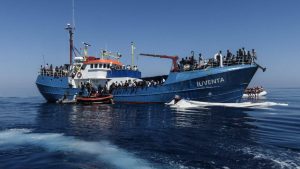
The ship selected to become Jugend Rettet’s active contribution to Maritime Search and Rescue in the Central Mediterranean Sea was acquired in May 2016, converted and refitted by the tremendous effort of many volunteers for her new task and christened IUVENTA.
Originally the 33m long IUVENTA was designed as a fishing vessel for the rough and frequently hostile conditions of the North Sea. Redundant features can be found throughout the ship such as two auxiliary engines and design elements of the main engine that ensure continuous operation even in the roughest conditions.
The once large deck spaces for working fishing gear was decluttered in the conversion to allow the accommodation of up to 100 rescued persons. Tarpaulins can be arranged to either protect the deck space from the sun or provide shelter from wind and rain.
In normal rescue operations the crew complement is between 11-13 persons.
Did you notice that? Let me repeat it:
The once large deck spaces for working fishing gear was decluttered in the conversion to allow the accommodation of up to 100 rescued persons.
“[U]p to 100” people. Not 400. And certainly not 600. One hundred. Maximum. So how did those other hundreds–and seven pregnant women–fit onboard? Did they hang on the sides? Waterski at the back? And you’ll note that the Iuventa didn’t broadcast a Mayday because it was overloaded. It lifted all those hundreds of people safely onto its Tardis-like deck and the Mayday was only a precautionary measure due to worsening weather conditions.
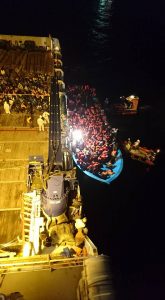
This picture from the news item is of refugees being moved from a smaller blue boat to a larger ship, but there’s conveniently no attibution. The photo could have been taken three or four years ago in a different part of the world completely and we’d never know the difference. In fact, if you compare the pictures of this boat with the one from the Jugend Rettet site, you’ll notice they are two different vessels! Busted!
France
Let’s go next to Paris. Here’s a short report from PressTV:
The refugee crisis is causing increasing violence and misery across the country, we’re told. Calais, the worst camp in France, has 10,000 people. Really? The worst camp in entire France has only ten thousand inhabitants?
At the 0:48 mark, we’re told that, “In this north Paris neighbourhood, refugees line the streets for nearly half a kilometre.” Half a kilometre is five hundred metres. What do you think the refugee density of that five hundred metres is? Let’s say we allocate one person per metre, taking into account the trees, rubbish bins, bus stops, benches, and so on. Refugees line both sides of the wide pavement, so…one thousand refugees? One thousand people is an overwhelming crisis? If you watch the entire video, you’ll see a number much much lower than that. Maybe a few hundred. Is Europe really panicking over a few hundred people in the north of Paris (population 2+ million)?
If you do some more research on these refugees in the northern suburbs of Paris, you’ll read that the government is building a refugee centre that can house only four hundred people. It sounds ridiculous, callous and is meant to highlight the plight of the poor refugees…unless the government knows something we don’t. Take over a stadium–or disused factory (there must be a few of them around)–and juryrig cubicles and you’ll soon notice if a factory that could house, say, 1,000 people isn’t bursting at the seams. But build something deliberately small and suddenly you can talk about its inadequacy and weep over frozen children until the cows come home.
Next, we’re off to Germany.
Germany
“Refugee Surge in Germany Puts Pressure on Small Towns” says The Wall Street Journal – Sumte (pop 114) is getting 80 refugees.
“German town of 100 must take 1,000 Syrian migrants” says WND, but it’s Sumte again.
“German Village of 102 Braces for 750 Asylum Seekers” comes from The New York Times…but it’s our old friend Sumte yet again.
“German town struggles with influx of refugees” says CNN, where the 1,100 people of Friedland now has “almost 4,000” refugees. The problem? Friedland has a population of 12,500 and is actually a consolidation of Friedland (which is where the 1,100 figure must have come from), Klein Schneen, Lichtenhagen, and Reiffenhausen. (Wikipedia)
“Refugee fight in Germany” is a YouTube video from TomoNews US and was allegedly filmed in…Friedland.
“Refugee crisis: Germany creaks under strain of open door policy” is from The Guardian, but the paper plays it smart: no named towns, no solid figures:
Reports of a youth community project having to move out to make way for an asylum seeker shelter, or a woman living in local authority housing being forced to downsize so that her flat could be used by refugees are regularly making the headlines and stoking resentment.
Convenient, I’d say. And this unexpected snippet:
At LaGeSo, the State Office for Health and Social Services in Berlin, where refugees go to be registered, both the chaos and the tensions among the estimated 1,500 people waiting for their number to be called – some of whom had been there for 35 days…
Only 1,500 in the State Office in the capital of Germany, Berlin? After a wait of 35 days? Shouldn’t there be, oh I don’t know, tens of thousands?
So I hope you can understand my mirth when I read that “Germany says it lost 130,000 refugees” (Business Insider Malaysia) or, better yet, 300,000 refugees according to The Times (“Germany’s 300,000 ‘lost’ refugees”) or, better yet still, 600,000 refugees (“Surprise: Germany Has No Clue Where at Least 600,000 Refugees From Terror Hot Spots Are Located”) from some conservative mob called Townhall. I await the breaking of the million-refugee barrier with the same kind of breathlessness with which test pilots once approached the sound barrier.
Sweden
We’re still in a bouncy mood, aren’t we? Let’s go to my favourite passive-aggressive fascist country and US collaborator, Sweden. Oh, what a shame. Pity the Swedes aren’t as particular as the Germans. This, from the New York Post:
Sweden welcomed more than 160,000 asylum-seekers in 2015, and nearly 40,000 in October of that year alone.
But those are the very figures I’m attempting to debunk, so that’s no help at all. In fact, Sweden is very big on anecdote, but short on hard local figures.
Okay, I know it’s Truth Revolt, but here’s what they say (“The Swedish Town Destroyed by ‘Refugee’ Crisis”):
The suburb Mölndal, a 20-minute tram ride from Sweden’s second largest city Gothenburg, welcomed with open arms more unaccompanied refugee “children” (under the age of 18) than anywhere else in the country – 4,041 added to a population of 63,000.
Refugees were shipped to Limedsforsen, not to settle but merely to have them stay somewhere while their applications were processed (“Refugees refusing to leave bus in ‘too cold’ Swedish village to be removed”). The number of refugees was a massive…60.
Admittedly ReliefWeb concentrates on children, but “Refugee influx weighs on Swedish towns” can only come up with “570 new young people who have arrived in the municipality this year” and “about 50 new arrivals who spent several months in the queue for Hässleholm ungdomscentrum, the ‘youth center’ where new arrivals between 16 and 20 years of age are sent to be prepared for secondary school.” Even if we triple those numbers to cater for parents, we’re still talking less than 2,000 people in total at a brand new refugee camp in southern Sweden.
What I like about the Swedish approach is that their newly-built refugee camps are all kilometres away from the nearest towns. Twenty kilometres from Stockholm, thirty kilometres from Malmö. Not exactly places where one could casually drop in and check on the official figures, are they? Let’s have a look at this report from the BBC:
Although they try to crop it well, it’s obvious that the “refugee camp” houses no more than fifty people. The presenter also makes obviously false statements. You can’t go anywhere in Södertälje without bumping into a migrant, he tells us. (Södertälje is thirty kilometres southwest of Stockholm, population approximately 75,000.) And he somehow conflates “migrants” with “refugees” (*), so he gets us thinking that all non-white people in Södertälje somehow ran away from oppression. (And where did this oppression come from? Ah, but that isn’t important.) What he doesn’t tell us is that Södertälje is predominantly Assyrian and they detest Muslims due to historical oppression. Hmmm. Not quite the Muslim melting pot that the presenter makes out, is it?
The representative from the Assyrian Federation of Sweden, Affram Yakoub, says at around 2:02 that some migrants were so disappointed with Sweden that they tried to go back. And, of course, one brown face looks very much like another (much as a Swede looks like a Dane looks like a German looks like a Belgian to me), so we can just take it for granted that one Assyrian speaks for all Syrians, Kurds and Iraqis as well. Why not?
Parallels has a heartwarming story, “In A Small Swedish Town, Residents Welcome Migrants” where the town of Ronneby (pop 30,000) has taken in “nearly 2,500 migrants” [my emphasis]. To be fair, Wikipedia states that Ronneby’s population is less than half that (12,029 as at 2010) but still, not even 2,500 refugees? Adding up all the numbers, where did the other 100,000+ disappear to? Maybe Germany knows.
Italy
All roads lead to Rome. Let’s see. (Italy was supposed to accept more than 80,000 refugees during 2015 alone, just so you know.)
From The Guardian (“Tensions run high in Rome’s suburbs as Italy struggles with migration crisis”), we read that:
more than a dozen police officers were injured in the [Roman] enclave as they fended off violent protesters demonstrating against the arrival of 19 migrants
That’s a big fat…nineteen.
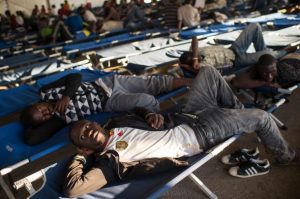

In National Geographic’s “Amid Record Waves of Refugees, Italy Finding Limits to Its Compassion”, we see a line of “roughly 500 newcomers” but, if you count them, you come up with around thirty. I’ve seen bigger line-ups at Californian post offices. Even with the “African arrivals…wait to be registered” photo, you’ll notice that half the bunks are empty and the number of people in the photo are, again, around thirty to forty. This photo contradicts another one further down that talks about “Hundreds of African migrants await[ing] registration” in the very same town, Augusta (Sicily). As an exercise in perception, I counted the number of people in the photo and came to…about one hundred. You’ll note that all the photos you see are either closely cropped or irrelevant (like a scrap of paper or a child’s shoe). It’s a bit like those 1,500 people waiting in Berlin for more than a month.
Spain
Spain is an interesting case because it’s so close to north Africa. It should be teeming with refugees, especially from Nigeria and those regions.
El Pais, in “Spain will take in more refugees but says it is overwhelmed by petitions” is talking about maybe taking more than 2,749 for 2015:
Spain received 2,588 asylum claims in 2012, 4,513 in 2013 and 5,952 in 2014.
Later that same year, Fortune magazine (“In Spain, and all of Europe, cities open doors to refugees”) admitted that:
Spain said it could only accept 2,749 refugees of the 5,849 the EU had asked it to take, and last week Deputy Prime Minister Soraya Sáenz de Santamaría reiterated that the country was “very saturated” with immigrants.
Even The Local (Spain) admitted in April last year that “the actual number of people Spain has taken in is strikingly low – just 18 in the past six months.” Oops.
So if they aren’t in Germany or Spain or Sweden or France or Italy (and they sure as hell aren’t in Austria, Central Europe or Hungary), where are these millions of people?
Discussion
You can see that the overall refugee figures as reported in various newspapers are huge: 160,000 here, 1.4 million there, but when you break it down, to actually begin looking at where those people actually are, then the picture becomes, shall we say, less than clear-cut, just like those 400/600 people on a boat that can, in reality, only accommodate only around ninety.
What is going on here? Firstly, let me say that I’m not saying there are no refugees. Of course there are, there are countless videos of them streaming across Europe. But are there millions of them streaming across Europe? I say no.
As a thought exercise, just watch a stadium emptying. See how many people seem to pour out of every orifice? And that’s just 30-50,000 people. If you have a stadium full of people in mind, then when you look at the refugee videos again, you’ll realise that what you’re seeing is, at most, a few thousand. Not a hundred thousand. And certainly not a million. If only 1,500 people have been waiting for more than a month at an office in the German capital of Berlin to get their visa papers then, again, we’re not talking about hundreds of thousands of people flooding Germany. Yes, there are thousands. They may well include rapists and terrorists and other unsavoury characters (and I’m sure they do…probably all those “moderate rebels” we’ve been hearing about), but there aren’t millions of them.
Mobs like whathitthefan like to stir the hate with their YouTube video , “Visit a refugee camp in Sweden”, but the joke’s up before the two-minute mark when we see a bottle of champagne in an ice bucket waiting for a pair of “refugees”. If the Swedish authorities are so conciliatory towards Muslim refugees, why would they provide something that is so obviously haram (forbidden)? The filmmakers would have done equally well hanging a ham from the chandelier.
Surely if the crisis is as large as advertised, there would be nothing stopping an ambitious photographer from climbing a tower somewhere and taking photos of these hordes of people? But there aren’t any.
This photo from Liberty News purports to show a bunch of refugees in some European city. Notice the open space at the back of the crowd and to your left. And I did a rough count. Even including the obvious camera crews and interested bystanders, there were no more than four hundred, maybe four hundred and fifty, people in that crowd. Not even half a thousand. And may I commend to your viewing the march of government leaders after the Charlie Hebdo attack. What we saw:
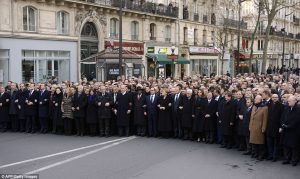
What it actually was:

Okay okay, you say, I get it already. You have me half-convinced that there’s something fishy about the refugee picture. But why?
Well, let the speculation begin. I’m not privy to confidential government despatches. I can only deduce matters from what I see and read. This is what I’ve deduced.
The first thing that strikes me is that this is a masterful psyop and my hat’s off to the architects. Well done. What they’ve managed to do is simultaneously entrench two diametrically opposite views with the one series of events. The progressives hate the conservatives for being so unfeeling, and the conservatives hate the progressives for being so openly stupid. God forbid that everyone should band together and go after the real villains in the world: the oligarchs and bankers. Notice how they’re getting a free ride now? You can say, “the stock market movements make absolutely no sense, there’s something wrong”, and you’ll be told, “look at all those bloody refugees swarming into Europe like diseased rats”. You can say, “we should lobby to stop any bank being given a trillion-dollar bailout that we know they’ll misuse”, and you’ll be told, “what matters is what we do now, and we need to welcome refugees with open arms”.
In other words, the refugee crisis has essentially removed the “common ground” between groups. If you substitute “brown person” for the cat, and “clueless European population” for the pigeons, I’m sure you can see where I’m going with this.
(*) I know that some people think that “refugee” is a racist term and that “migrant” should be used. But if a person is fleeing some kind of situation in their home country that they find unbearable, then I think the word “refugee” fits. And it’s not just for brown people. There are “refugees” from the USA who’ve settled in New Zealand, for example. They are escaping what they consider to be an intolerable situation in their homeland. They aren’t migrants. They’re refugees. Doesn’t matter what colour their skin is.
Copyright © KS Augustin, 2017
* If you liked this article, please consider the Paypal tipjar in the site’s sidebar. I’ll be trying to hit big issues in ways that may not be obvious twice a month, on the first and fifteenth, and every cent helps. Thank you.
